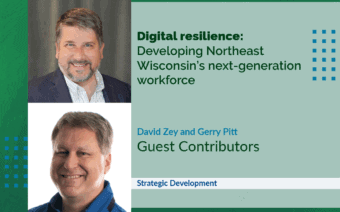
September 9, 2022
NORTHEASTERN WISCONSIN – The COVID-19 pandemic taught the world many things – one of them being the importance of connectivity.
When the pandemic abruptly shifted life online, it only further cemented the importance of widespread, affordable and accessible high-speed internet.
Broadband – be it fiber, wireless, cable, DSL or satellite – was the topic of discussion at a recent seminar hosted by the Wisconsin Tomorrow Action Accelerator on Broadband.
During the four-hour session (Broadband: The New Economic Necessity held at Fox Valley Technical College in Appleton) five panelists – Jaron McCallum, Bob Webb, August Neverman, Steve Schneider and Jim Wood – fielded questions about the next steps in the broadband strategy for Northeast Wisconsin.
Why is it taking so long for broadband to arrive?
Schneider, the president and CEO of Bug Tussel Wireless, said limited resources are probably the No. 1 answer to that question.
“The next best answer is the decision-making process takes a long time – not just from private industry, but some counties work faster than others,” he said. “Some counties had plans as far back as 2012 – they are way ahead of the game. There are counties just now forming broadband committees – they’re behind.”
Schneider said another reason for the delay is something many businesses are currently dealing with today, post-COVID-19 pandemic – supply chain issues.
“It affects all of us, and that continues to be a burden,” he said.
Webb, the vice president of Innovative Operations with Nsight Telservices, said it doesn’t have to take a long time to get broadband, even in rural areas.
He said Nsight goes about the process in a slightly different way.
“Nsight’s focus is working directly with villages and towns,” he said. “We think that’s the right way to do it. We signed a fiber project agreement in February 2021 with the Village of Luxemburg – 1,200 households. As of June 30, everyone in that village has access to fiber in their homes, with minimum speeds of 300 Mbps.”
Webb said there’s a big difference between mainline/long-haul fiber and distribution fiber.
“In a nutshell, the existence of a mainline fiber near you doesn’t necessarily mean you’ll have broadband service,” he said.
High costs
Neverman, the Broadband and BCCAN (The Brown County Community Area Network, pronounced BEACON) Director of Brown County, said the cost of passing broadband still has to warrant installing it.
“If you can’t make the revenue match the cost for passing (meaning an installed cable “passes” close enough to a home or business to be eligible for services), you’ll lose money going there,” he said. “For many rural spots – even in Brown County – it’s like $14,000 a passing, and that’s just the Spectrum cost. I think every provider would agree – if you have enough cash, you could make (broadband) happen everywhere.”
In late June, the Public Service Commission of Wisconsin awarded almost $125 million in funding for 71 projects in the state’s Broadband Expansion Grant Program.
The projects, which are aimed at unserved/underserved areas, will bring broadband to almost 83,000 residences and more than 4,500 businesses in 45 counties.
The money is part of funding provided for broadband expansion under the 2021-23 state budget.
The projects will be supplemented by almost $186 million in matching funds from recipients.
“I’m a little nervous on this,” Neverman said. “If you look at the map of the state, there’s a challenge here. (The) billion-dollar (estimate Wisconsin might be getting) would get us farther than we are today, guaranteed. I don’t want to sound doom and gloom, but I don’t know how far down the road it will get us. When you start doing the math…”
Webb said to make broadband work financially, it’s going to take a collaborative effort.
“It will take grants, private investments and public investments,” he said. “Every success story we’ve had, it’s taken towns and villages making significant investments – on top of state dollars. The state money is a foundation to help – not the be all, end all.”
Barb LaMue, president and CEO of New North Inc., a 501(c)3 regional economic development nonprofit, said having a broadband strategy session with industry and community leaders is invaluable.
“Together, we can improve the lives of those in Northeast Wisconsin,” she said.
Brown County
Brown County officials are currently negotiating a more than $27 million loan to bring high-speed service to almost all its residents.
The county is working with Bug Tussel, a Green Bay-based internet provider, which specializes in bringing services to rural communities.
Schneider said it could mean most of the county will have high-speed internet within 18 months to three years of the deal’s finalization.
“We’re excited to bring higher-speed broadband, particularly, to rural Brown County,” he said. “Broadband opens the door to doing things wherever you’re located. Some of the rural folks have been inhibited in what they can do. We view ourselves as a catalyst for this. We’re looking at the entire strategy for the long run so it will position the community for the future.”
Schneider said there would be several packages available.
?

Broadband and BCCAN Director of Brown County and seminar panelist August Neverman. Rich Palzewic Photo
“It could range from 300 Mbps to 1 Gbps,” he said. “We’re putting the infrastructure in to get more than 1Gbps.”
Schneider said the difference between 5 Mbps and 1 Gbps is “astronomical.”
“If you have the slower speed as you might in rural areas, it could take 25 minutes to download a Netflix video,” he said. “With 1 Gbps, it would be instantaneous. It’s our goal to get a minimally acceptable speed to everyone as soon as possible.”
Schneider said Bug Tussel is also partnering with local cellular providers to improve cellular service.
“That won’t only benefit rural Brown County, but there are also cellular holes in the Green Bay Metro area, too,” he said.
The plan calls for the installation of a 270-mile fiber network, along with 14 fixed wireless sites.
Town of Morrison
Tom Kempen, the Town of Morrison chairperson, said his rural community has seen first-hand the issues of slow service – or no service altogether.
“It will certainly be an advancement of technology for us,” Kempen said. “It will allow people to take care of things at home they haven’t been able to. Anytime you get higher bandwidth, there are more capabilities.”
Kempen said as an agricultural area, broadband will offer many opportunities for Morrison.
“When it comes to this area, it will allow the larger farmers to run unoccupied tractors, to plant seed corn in a more precise pattern and to monitor the feed their cattle are consuming,” he said. “This is something area farmers have only dreamed about in the past.”
Kempen said currently, Morrison’s internet speed is “poor.”
“There are maps on the Brown County website that illustrate how poor the coverage is,” he said. “The State of Wisconsin and the federal government have defined what they consider unserved/underserved, and the Town of Morrison is mostly unserved with some underserved small pockets around a CenturyLink hub.”
Kempen said elections show exactly what can happen with no service.
“At the end of the election nights, you’re supposed to report the results to the county,” he said. “The county signed an agreement with Verizon for their internet access, but in Morrison, Hollandtown and Glenmore, there is zero Verizon coverage.”
Kempen said the election machines are designed to transmit results to the county once elections are complete.
“How can you send results when there is no coverage?” he said. “So, you have two options – download the results onto a flash drive and bring that to the county, or you physically put the voting machine in someone’s vehicle and drive around until you find a signal closer to Green Bay.”
Kempen said in most past elections, the second option worked.
“It didn’t work in the Aug. 9 primary,” he said. “We had people drive to multiple locations, but the machine wouldn’t transmit. Ultimately, they went back to the town halls and loaded the results onto the flash drive and got it to the county – it’s ridiculous.”
In this age of election integrity, Kempen said examples like this don’t help.
“I hate to make this link, but here you have a voting machine with election results in somebody’s car who is chasing around the county trying to find a signal, risking damage to the machine in an accident – it’s unheard of,” he said.
 Walkable communities on the rise
Walkable communities on the rise Homeschooling parents open The Homie Hub in Oshkosh
Homeschooling parents open The Homie Hub in Oshkosh








